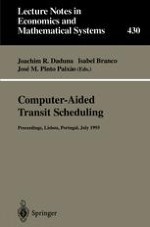1995 | OriginalPaper | Chapter
Train Scheduling — Migration of Manual Methods to Scalable Computer Platforms
Author : Richard Wallace
Published in: Computer-Aided Transit Scheduling
Publisher: Springer Berlin Heidelberg
Included in: Professional Book Archive
Activate our intelligent search to find suitable subject content or patents.
Select sections of text to find matching patents with Artificial Intelligence. powered by
Select sections of text to find additional relevant content using AI-assisted search. powered by
This paper will describe the evolution of train scheduling in London Underground over the past thirty years and will show how developments in signalling contributed to the initial implementation of a validated timetable datafile. Establishment of the first system concepts enabled further development to produce a completely computerised environment to facilitate planning and scheduling of trains together with the ability to cater for diverse production requirements. This includes provision of control documentation, statistics and signal data. The early implementation of such a system ensured that, when the new generation of centralised control systems began to be installed, data files and subsequently a common database were already available to facilitate provision of planned data in a controlled fashion.Today, there is a focus on quality of service and a need to be able to assess planned against actual performance. Existence of the schedule system ensured that automation of data capture and the potential for ‘real time’ assessment was feasible, thus enabling the Company to embark upon development of more sophisticated management information and control systems. Further developments will enable the consideration of providing ‘real time’ service planning systems to improve even further the quality of service provided.
